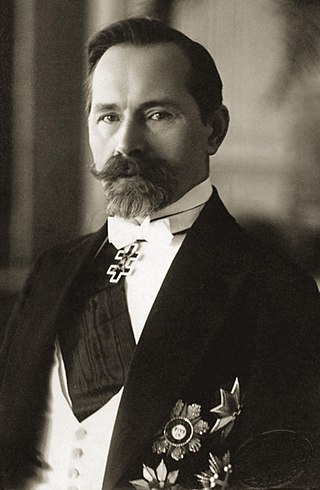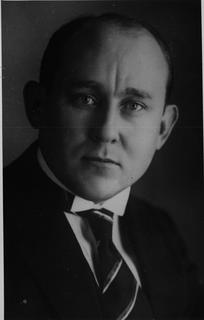Related Research Articles

Antanas Smetona was a Lithuanian intellectual, journalist and politician who served as the first president of Lithuania from 1919 to 1920 and again from 1926 until the Soviet occupation of Lithuania in 1940. Referred to as the "Leader of the Nation" during his presidency, Smetona is recognised as one of the most important Lithuanian political figures between World War I and World War II, and a prominent ideologists of Lithuanian nationalism and the movement for national revival.

Augustinas Voldemaras was a Lithuanian nationalist political figure. He briefly served as the country's first prime minister in 1918 and continued serving as the minister of foreign affairs until 1920, representing the fledgling Lithuanian state at the Versailles Peace Conference and the League of Nations. After some time in academia, Voldemaras returned to politics in 1926, when he was elected to the Third Seimas.

Aleksandras Stulginskis was the second President of Lithuania (1920–1926). Stulginskis was also acting President of Lithuania for a few hours later in 1926, following a military coup that was led by his predecessor, President Antanas Smetona, and which had brought down Stulginskis's successor, Kazys Grinius. The coup returned Smetona to office after Stulginskis's brief formal assumption of the Presidency.

Mykolas Sleževičius was a Lithuanian lawyer, political and cultural figure, and journalist. One of the most influential figures in inter-war Lithuania, he served as the prime minister of Lithuania on three occasions. Taking the helm of the government at a difficult time in 1918 and again in 1919, Sleževičius has been credited with preparing Lithuania for the fights to come and for laying the foundations of the fledgling state.

Ernestas Galvanauskas was a Lithuanian engineer, politician and one of the founders of the Peasant Union. He also served twice as Prime Minister of Lithuania.
The State Council of Lithuania was a legislative institution in interwar Lithuania. It was an advisory institution that codified existing and proposed new laws. It was established by the constitution adopted on 15 May 1928. President Antanas Smetona dismissed the Third Seimas in March 1927. Although the constitution of 1928 retained the Seimas as the legislative body, new elections were not called until June 1936. In the absence of a parliament, the State Council performed some legislative functions of the Lithuanian government. It was liquidated on 26 July 1940 by the People's Government of Lithuania. Its chairman in 1928–1938 was Stasys Šilingas who became the prime legal architect of the authoritarian regime of Smetona. The archives of the council were lost after the Soviet occupation. Therefore, its activities are known mainly from the press, memoirs of its members, and documents of other institutions.

Leonas Bistras was one of the most prominent Lithuanian politicians of the interwar period. A Christian Democrat, he was in 1925 appointed Prime Minister of Lithuania. Bistras also headed the ministries of education, defense and foreign affairs in several different governments throughout 1920s and 1930s and twice served as the speaker of the Lithuanian parliament, the Seimas. After the 1926 Lithuanian coup d'état and the subsequent fall of parliamentary democracy, Bistras led the Christian Democrats and, despite persecution, acted as an outspoken leader of the opposition to the authoritarian President Antanas Smetona.

The 1926 Lithuanian coup d'état was a military coup d'état in Lithuania that replaced the democratically elected government with a nationalist regime led by Antanas Smetona. The coup took place on 17 December 1926 and was largely organized by the military; Smetona's role remains the subject of debate. The coup brought the Lithuanian Nationalist Union, the most conservative party at the time, to power. Previously it had been a fairly new and insignificant nationalistic party. By 1926, its membership reached about 2,000 and it had won only three seats in the parliamentary elections. The Lithuanian Christian Democratic Party, the largest party in the Seimas at the time, collaborated with the military and provided constitutional legitimacy to the coup, but accepted no major posts in the new government and withdrew in May 1927. After the military handed power over to the civilian government, it ceased playing a direct role in political life.

The Third Seimas of Lithuania was the third parliament (Seimas) democratically elected in Lithuania after it declared independence on 16 February 1918. The elections took place on 8–10 May 1926. For the first time the Lithuanian Christian Democratic Party were forced to remain in opposition. The coalition government made some unpopular decisions and was sharply criticized. Regular Seimas work was interrupted by a military coup d'état in December 1926 when the democratically elected government was replaced with the authoritarian government of Antanas Smetona and Augustinas Voldemaras. The Third Seimas was dissolved on 12 March 1927 and new elections were not called until 1936.
The Fourth Seimas of Lithuania was the fourth parliament (Seimas) elected in Lithuania after it declared independence on 16 February 1918. The elections took place on 9 and 10 June 1936, a bit less than ten years after the Third Seimas was dissolved by President Antanas Smetona. The Seimas commenced its work on 1 September 1936. Its five-year term was cut short on 1 July 1940 when Lithuania lost its independence to the Soviet Union. It was replaced by the People's Seimas in order to legitimize the occupation. Konstantinas Šakenis was the chairman of the Seimas.

The Ministry for Belarusian Affairs was a short-lived interwar Lithuanian ministry. It was established in December 1918 to gain support of Belarusians in international negotiations over the borders of the newly independent Lithuania. However, the Lithuanian government did not support Belarusian autonomy and the ministry effectively competed with the Rada of the Belarusian Democratic Republic. Activities of the ministry were limited to publication of several books and two periodicals and other cultural work. The ministry was officially closed in January 1924.
Parliamentary elections were held in Lithuania on 10 and 11 October 1922, electing 78 members of the First Seimas. They were the first elections held in Lithuania under the 1922 constitution, which had been adopted by the Constituent Assembly on 1 August 1922.
The Farmers' Party was a liberal political party in inter-war Lithuania.
Vairas was a Lithuanian-language political and cultural newspaper published by Antanas Smetona and the Lithuanian Nationalist Union, the ruling party in Lithuania in 1926–1940. It was published three separate times. Vairas was first established in January 1914 when Smetona departed Viltis; it was discontinued due to World War I. The newspaper was briefly revived in September 1923 when Smetona and Augustinas Voldemaras harshly criticized their political opponents and the Lithuanian government. Due to anti-government rhetoric, their newspapers were closed by state censors one after another, but they would quickly establish a new newspaper under a new title. Vairas was closed in February 1924. The newspaper was reestablished as a cultural magazine in 1929 with the backing of the authoritarian regime of Smetona. In 1939, it became a weekly political magazine that pushed an agenda of radical nationalism and openly sympathized with National Socialism. The magazine was discontinued after the Soviet occupation of Lithuania in June 1940.

Varniai concentration camp was an internment camp in Varniai, Lithuania. It was created a month after the coup d'état of December 1926 to house political prisoners, mostly members of the outlawed Communist Party of Lithuania. In total, more than 1,000 people passed through the camp before it was closed in 1931 due to financial difficulties brought by the Great Depression. Later, the authoritarian regime of Antanas Smetona operated two other internment camps, one in Dimitravas in 1936 and another in Pabradė in 1939.

Rapolas Skipitis was a Lithuanian attorney and politician. In 1920–1922, he was Minister of the Interior and was later elected to the Second and Third Seimas. After the 1926 coup d'état, he chaired the Lithuanian Riflemen's Union (1927–1928), Society for the Support of Lithuanians Abroad (1932–1940), and several other Lithuanian organizations. He also edited several newspapers, including Ūkininko balsas (1925–1928), Trimitas (1927–1928), Namų savininkas and Pasaulio lietuvis (1937–1940). At the start of World War II, he retreated to Germany and joined the Lithuanian Activist Front. He was reserved the seat of Minister of Foreign Affairs in the Provisional Government of Lithuania. After the war, he settled in Chicago where he was active in Lithuanian American cultural life.

Sofija Smetonienė, was the wife of the first President of Lithuania Antanas Smetona and served as the First Lady of Lithuania from April 4, 1919, to June 19, 1920, and again from December 19, 1926, to June 15, 1940. Sofija was a member of the Chodakowski noble family.

The Lithuanian Nationalist Union, also known as the Nationalists, was the ruling political party in Lithuania during the authoritarian regime of President Antanas Smetona from 1926 to 1940. The party was established in 1924 but was not popular. It came to power as a result of the December 1926 military coup. From 1927 to 1939, the Council of Ministers included only members of the LTS. In 1936, other parties were officially disbanded, leaving LTS the only legal party in the country. At the end of the 1930s new members started bringing in new ideas, right wing and closer to Italian Fascism. The party was disestablished after the Soviet occupation of Lithuania in June 1940. A party of the same name was reestablished in 1990 and claims to be the successor of the interwar LTS.
Romanas Chodakauskas was the Lithuanian military attaché to Berlin, a Lithuanian Diplomat in the Ukrainian People's Republic, a Colonel in the Lithuanian Military Court, and brother of Sofija Smetonienė, Tadas Chodakauskas and Jadvyga Tūbelienė. Romanas was a member of the Chodakowski noble family.
The coup d'état attempt in 1934 was an attempt by voldemarininkai, supporters of the former Prime Minister Augustinas Voldemaras, to overthrow the government of President Antanas Smetona. While voldemarininkai planned several coups against the government, this coup was the largest and most threatening.
References
- Banevičius, Algirdas (1991). 111 Lietuvos valstybės 1918–1940 politikos veikėjų (in Lithuanian). Vilnius: Knyga. pp. 11–33. ISBN 5-89942-585-7.
- Eidintas, Alfonsas; Vytautas Žalys; Alfred Erich Senn (September 1999). Ed. Edvardas Tuskenis (ed.). Lithuania in European Politics: The Years of the First Republic, 1918–1940 (Paperback ed.). New York: St. Martin's Press. pp. 199–206. ISBN 0-312-22458-3.
- "Ankstesnės vyriausybės > Laikotarpiu 1918–1940" (in Lithuanian). Government of the Republic of Lithuania. Retrieved 2008-09-01.
- Eidintas, Alfonsas (1990). Antanas Smetona (in Lithuanian). Vilnius: Mintis. pp. 233–238. ISBN 5-417-00376-X.
- Antanas Račys, ed. (2008). "Vyriausybė". Lietuva (in Lithuanian). Vol. I. Vilnius: Science and Encyclopaedia Publishing Institute. p. 263. ISBN 978-5-420-01639-8.